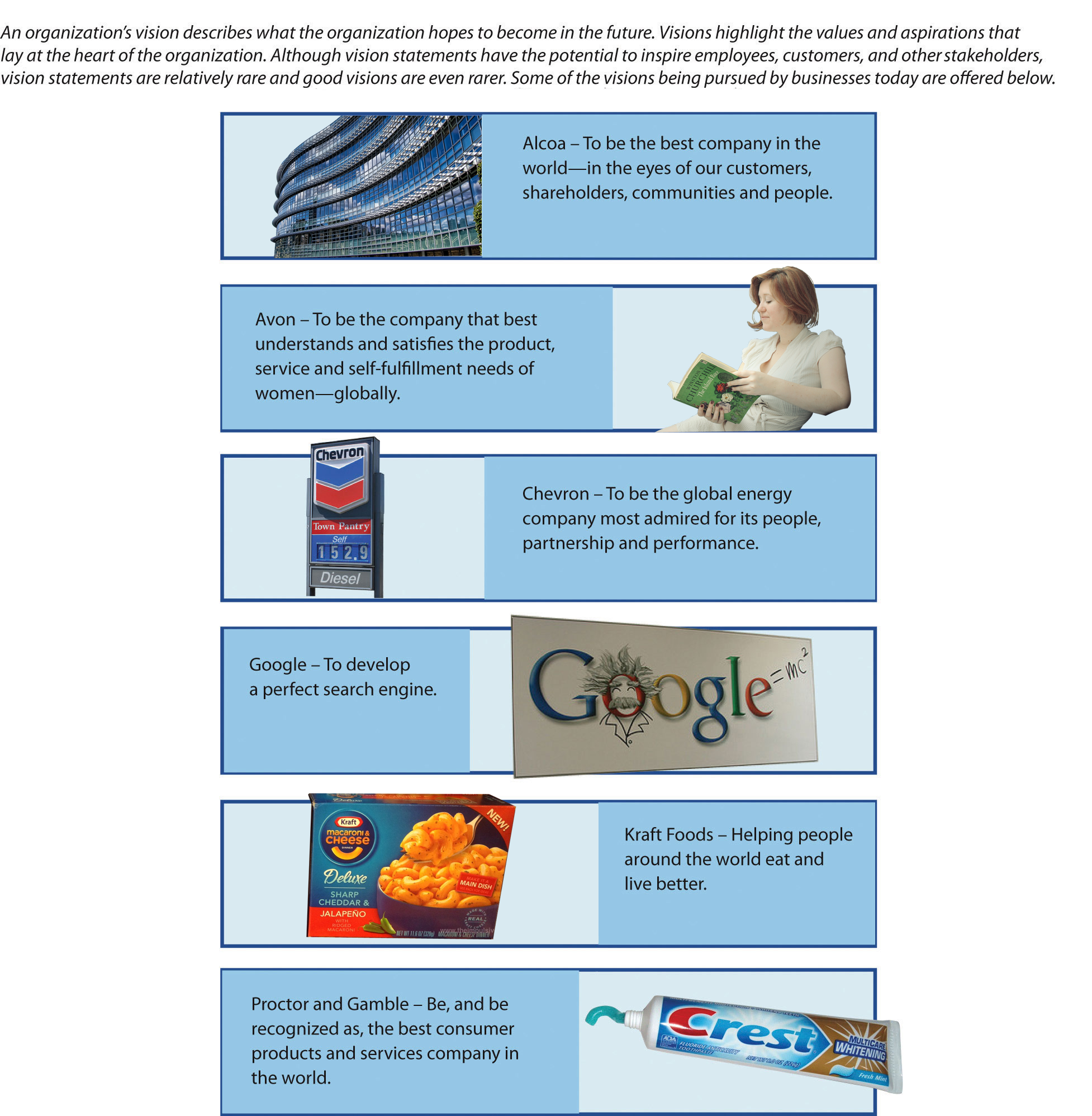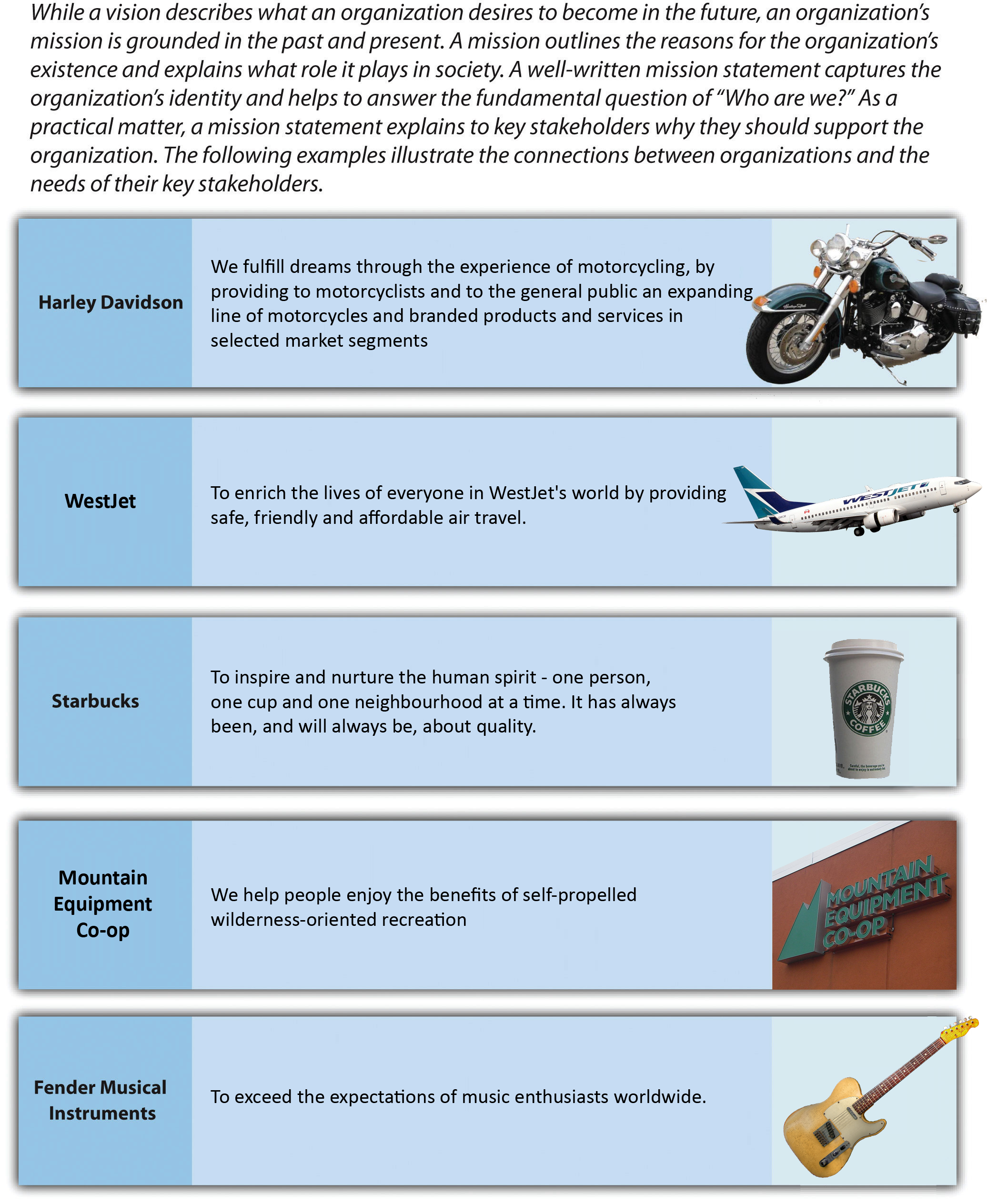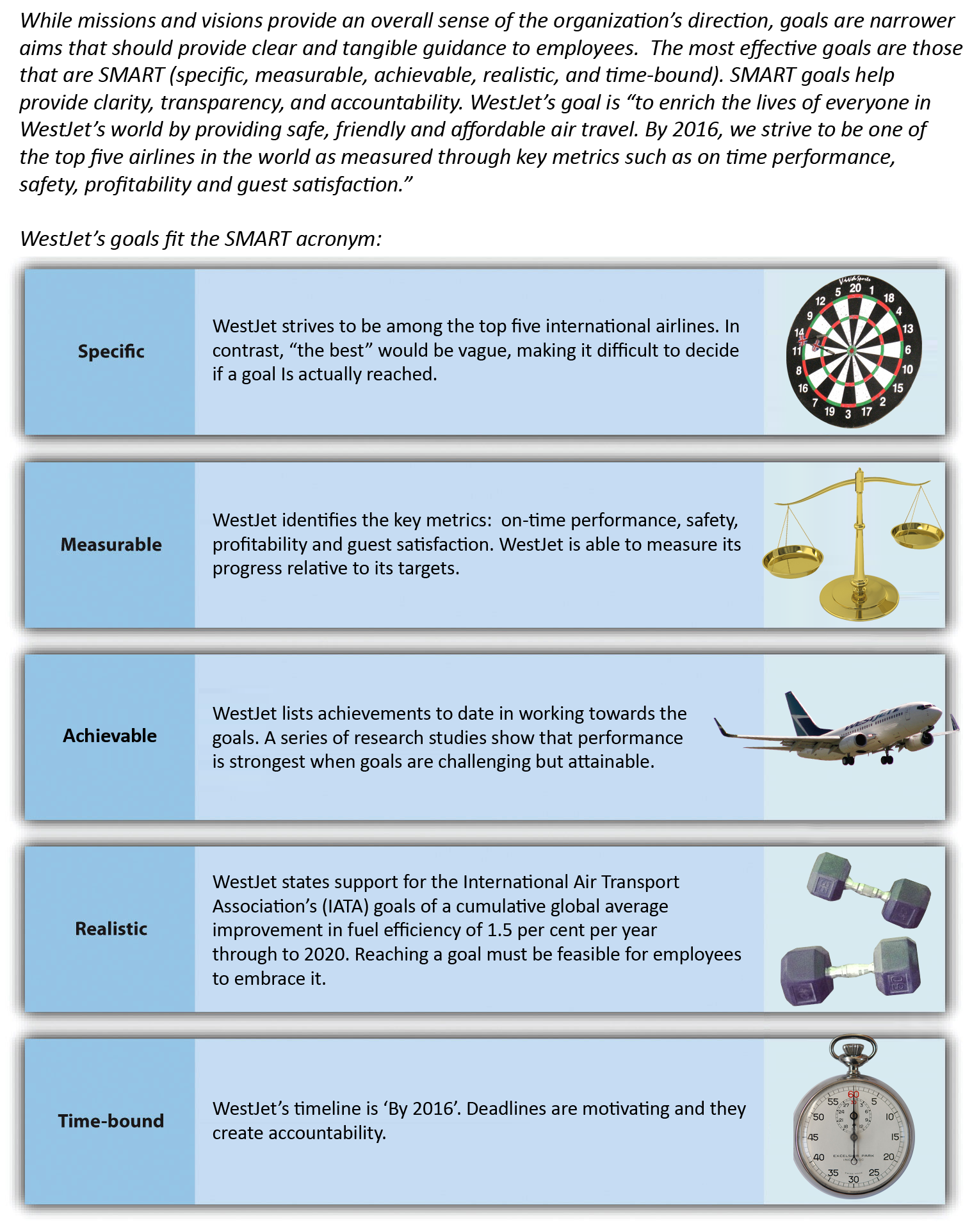Chapter 2: Leading Strategically
Vision, Mission, and Goals
Learning Objectives
- Define vision and mission and distinguish between them.
- Know what the acronym SMART represents.
- Be able to write a SMART goal.
The Importance of Vision
Good business leaders create a vision, articulate the vision, passionately own the vision, and relentlessly drive it to completion.
—Jack Welch, former CEO of General Electric
Many skills and abilities separate effective strategic leaders like Howard Schultz from poor strategic leaders. One of them is the ability to inspire employees to work hard to improve their organization’s performance. Effective strategic leaders are able to convince employees to embrace lofty ambitions and move the organization forward. In contrast, poor strategic leaders struggle to rally their people and channel their collective energy in a positive, focused direction.
As the quote from Jack Welch suggests, a vision is one key tool available to executives to inspire the people in an organization (Figure 2.2 “The Big Picture: Organizational Vision”). An organization’s vision describes what the organization hopes to become in the future. Well-constructed visions clearly articulate an organization’s aspirations. Google’s mission is to organize the world’s information and make it universally accessible and useful (Edwards, 2012). Google expands on its mission by listing “Ten things we know,” including “Focus on the user and all else will follow,” “It’s best to do one thing really, really well,” and “Fast is better than slow” (Google Inc., 2014).

This brief but powerful statement emphasizes several aims that are important to Google, including excellence in customer service, and setting high standards for employees and Google’s products. McDonald’s brand mission is “to be our customers’ favourite place and way to eat. Our worldwide operations are aligned around a global strategy called the Plan to Win, which centre on an exceptional customer experience – People, Products, Place, Price and Promotion. We are committed to continuously improving our operations and enhancing our customers’ experience.” To be effective, this mission statement must filter down to all employees and inspire them to adopt that mission. (Edwards, 2012).
One limitation of such all-encompassing goals is that front line and operational employees will not relate or connect with the goals, and will disengage from the process – flavour of the month…. The CEO/management team who can effectively translate the high-level objectives to on-the-ground activities will have good success in engaging staff! Of course, a strong element of walk-the-talk is required by management as well.
The results of a survey of 1,500 executives illustrate how the need to create an inspiring vision creates a tremendous challenge for executives. When asked to identify the most important characteristics of effective strategic leaders, 98 percent of the executives listed “a strong sense of vision” first. Meanwhile, 90 percent of the executives expressed serious doubts about their own ability to create a vision. Not surprisingly, many organizations do not have formal visions. Many organizations that do have visions find that employees do not embrace and pursue the visions. Having a well-formulated vision that employees embrace can therefore give an organization an edge over its rivals.
Mission Statements
At WestJet, Clive Beddoe and his team developed its mission statement: “To enrich the lives of everyone in WestJet’s world by providing safe, friendly and affordable air travel.” A mission such as WestJet’s states the reasons for an organization’s existence. Well-written mission statements effectively capture an organization’s identity and provide answers to the fundamental question “Who are we?” While a vision looks to the future, a mission captures the key elements of the organization’s past and present.

Organizations need support from their key stakeholders, such as employees, owners, suppliers, and customers, if they are to prosper. A mission statement which engages stakeholders will help develop an understanding of why they should support the organization and make clear what important role or purpose the organization plays in society – also called a “social license to operate.” Google’s mission, for example, is “to organize the world’s information and make it universally accessible and useful.” Google pursued this mission in its early days by developing a very popular Internet search engine. The firm continues to serve its mission through various strategic actions, including offering its Internet browser Google Chrome to the online community, providing free email via its Gmail service, and making books available online for browsing.
In ancient times, Aesop said, “United we stand, divided we fall.” This provides a helpful way of thinking about the relationship between vision and mission. Executives ask for trouble if their organization’s vision and mission are divided by emphasizing different domains. Some universities have fallen into this trap. Many large public universities were established in the late 1800s with missions that centered on educating citizens. As the 20th century unfolded, however, creating scientific knowledge through research became increasingly important to these universities. Many university presidents responded by creating visions centered on building the scientific prestige of their schools. This created a dilemma for professors: Should they devote most of their time and energy to teaching students (as the mission required) or on their research studies (as ambitious presidents demanded via their visions)? Some universities continue to struggle with this trade-off today and remain houses divided against themselves. In sum, an organization is more effective to the extent that its vision and its mission target employees’ effort in the same direction.
Pursuing the Vision and Mission through SMART Goals
An organization’s vision and mission combined offer a broad, overall sense of the organization’s direction. To work toward achieving these overall aspirations, organizations also need to create goals—narrower aims that should provide clear and tangible guidance to employees as they perform their work on a daily basis. The most effective goals are those that are
Specific,
Measurable,
Achievable,
Realistic, and
Time-bound.
An easy way to remember these dimensions is to combine the first letter of each into one word: SMART (Figure 2.4 “Creating SMART Goals”). Employees are in a much better position to succeed to the extent that an organization’s goals are SMART.A goal is specific if it is explicit rather than vague. WestJet’s vision is that “By 2016, WestJet will be one of the five most successful international airlines in the world providing our guests with a friendly caring experience that will change air travel forever.”
A goal is measurable to the extent that whether the goal is achieved can be quantified. WestJet’s goal of being one of the five most successful international airlines in the world by 2016 offers very simple and clear measurability: Either WestJet will be in the top five by 2016 or they will not.
A goal is aggressive if achieving it presents a significant (as opposed to easy) challenge to the organization. A series of research studies have demonstrated that performance is strongest when goals are challenging but attainable. Such goals force people to test and extend the limits of their abilities. This can result in reaching surprising heights.
WestJet committed to growing responsibly and ensuring that it is an environmentally sustainable airline, and supports the IATA goal of carbon neutral growth in its industry beyond 2020. WestJet already operates one of the most modern and fuel-efficient fleets in North America.
Achieving carbon neutral growth will be a challenge for WestJet requiring the combined efforts of the airline and its supplier partners such as aircraft manufacturers, airports and government. In 2012, WestJet reported that “Our significant investments in fleet and technology have greatly improved our aircraft fuel efficiency and ability to operate our business more cost effectively. Between 2000 and 2012, we improved our fuel efficiency by 44.8 per cent per revenue tonne kilometre. The resulting fuel savings are equivalent to the amount of fuel that would have been used to fly a Boeing Next-Generation 737 from Calgary to Toronto and back approximately 44,135 times (based on our 2012 fuel usage).” (Quigley, 1994)
It is useful to know that easily achievable goals are not only easy, but they tend to undermine overall motivation and effort by employees, Michelangelo said, “The greater danger for most of us lies not in setting our aim too high and falling short, but in setting our aim too low, and achieving our mark.” Consider a situation in which you have done so well in a course that you only need a score of 60 percent on the final exam to earn an A for the course. Understandably, few students would study hard enough to score 90 percent or 100 percent on the final exam under these circumstances Similarly, setting organizational goals that are easy to reach encourages employees to work just hard enough to reach the goals.

It is tempting to extend this logic and thinking to conclude that setting nearly impossible goals will encourage even stronger effort and performance from staff. However, people act rationally and tend to become discouraged and give up when faced with goals that realistically have little chance of being reached. If, for example, Starbucks had set a time frame of one year to regain a share price of $35, it would have attracted scorn. The company simply could not be turned around that quickly. Similarly, if WestJet’s fuel efficiency goal was 100 percent improvement, WestJet’s employees would probably not embrace it. Thus goals must also be realistic, meaning that their achievement is feasible.
Most of us have found that deadlines are motivating and that they help you structure your work time. The same is true for organizations, leading to the conclusion that goals should be time-bound through the creation of deadlines. WestJet has set a goal to achieve a cumulative 45 per cent improvement in fuel efficiency for our 737 fleet by 2020, as compared to the 2000 base year. (WestJet, 2012)
The period after an important goal is reached is often overlooked but is critical. Will an organization rest on its laurels or will it take on new challenges? Starbucks provides an illustrative example. In 2011, after a revamp of the company’s stores and services, the stock price was around $35. In early 2014, the price was in the $70 range.
Key Takeaway
Strategic leaders need to ensure that their organizations have three types of aims. A vision states what the organization aspires to become in the future. A mission reflects the organization’s past and present by stating why the organization exists and what role it plays in society. Goals are the more specific aims that organizations pursue to reach their visions and missions. The best goals are SMART: specific, measurable, achievable, realistic, and time-bound.
Exercises
- Take a look at the website of your college or university. What is the organization’s vision and mission? Were they easy or hard to find?
- As a member of the student body, do you find the vision and mission of your college or university to be motivating and inspirational? Why or why not?
- What is an important goal that you have established for your career? Could this goal be improved by applying the SMART goal concept?
References
Edwards, A. (2012). Mission Statements–World’s Top 10 Brands. Retrieved from http://communicatingasiapacific.com/2012/06/15/mission-statements-worlds-top-10-brands/
Google Inc. (2014). Ten things we know to be true. Retrieved from https://www.google.com.sg/about/company/philosophy/
Quigley, J. V. (1994). Vision: How leaders develop it, share it, and sustain it. Business Horizons, 37(5), 37–41.
WestJet Airlines Ltd. (2012). WestJet 2012 Global Reporting Initiative report [PDF]. Retrieved from https://www.westjet.com/pdf/global-reporting.pdf
Image descriptions
Figure 2.2 image description: The Big Picture: Organizational Vision.
An organization’s vision describes what the organization hopes to become in the future. Visions highlight the values and aspirations that lay at the heart of the organization. Although vision statements have the potential to inspire employees, customers, and other stakeholders, vision statements are relatively rare and good visions are even rarer. Some of the visions being pursued by businesses today are offered below.
- Alcoa – to be the best company in the world – in the eyes of our customers, shareholders, communities and people.
- Avon – to be the company that best understands and satisfies the product service and self-fulfillment needs of women – globally.
- Chevron – to be the global energy company most admired for its people, partnership and performance.
- Google – to develop a perfect search engine.
- Kraft Foods – helping people around the world eat and live better.
- Proctor and Gamble – be, and be recognized as, the best consumer products and services company in the world.
Figure 2.3 image description: Missions.
While a vision describes what an organization desires to become in the future, an organization’s mission is grounded in the past and present. A mission outlines the reasons for the organization’s existence and explains what role it plays in society. A well-written mission statement captures the organization’s identity and helps to answer the fundamental question of “who are we?” As a practical matter, a mission statement explains to key stakeholders why they should support the organization. The following examples illustrate the connections between organizations and the needs of their key stakeholders.
- Harley Davidson: we fulfill dreams through the experience of motorcycling, by providing to motorcyclists and to the general public an expanding line of motorcycles and branded products and services in selected market segments.
- Westjet: to enrich the lives of everyone in Westjet’s world nu providing safe, friendly and affordable air travel.
- Starbucks: to inspire and nurture the human spirit – one person, one cup and one neighbourhood at a time. It has always been, and will always be, about equality.
- Mountain Equipment Co-op: we help people enjoy the benefits of self-propelled wilderness-oriented recreation.
- Fender Musical Instrument: to exceed the expectations of music enthusiasts worldwide.
Figure 2.4 image description: Creating SMART Goals.
While missions and visions provide an overall sense of the organization’s direction, goals are narrower aims that should provide clear and tangible guidance to employees. The most effective goals are those that are SMART (specific, measurable, achievable, realistic, and time-bound). SMART goals help provide clarity, transparency, and accountability. Westjet’s goal is “to enrich the lives of everyone in Westjet’s world by providing safe, friendly and affordable air travel. By 2016, we strive to be one of the top five airlines in the world as measured through key metrics such as on time performance, safety, profitability and guest satisfaction.
Westjet’s goals fit the SMART acronym.
- Specific: Westjet strives to be among the top five international airlines. In contrast, “the best” would be vague, making it difficult to decide if a goal is actually reached.
- Measurable: Westjet identifies the key metrics: on-time performance, safety, profitability and guest satisfaction. Westjet is able to measure its progress relative to its targets.
- Achievable: Westjet lists achievements to date in working towards the goals. A series of research studies show that performance is strongest when goals are challenging but attainable.
- Realistic: Westjet states support for the International Air Transport Association’s (IATA) goals of a cumulative global average improvement in fuel efficiency of 1.5 per cent per year through to 2020. Reaching a goal must be feasible for employees to embrace it.
- Time-bound: Westjet’s timeline is “By 2016.” Deadlines are motivating and they create accountability.
What the organization hopes to become in the future.
Narrower aims that organizations pursue to serve their visions and missions.

